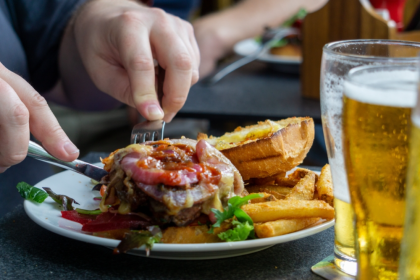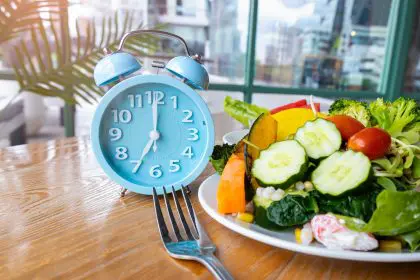You’ve been doing everything right. Swapped your lunchtime sandwich for a leafy green salad. Filled your Instagram with #SaladGoals. Even invested in those fancy glass meal prep containers. Yet somehow your blood sugar readings are all over the place. What gives?
Welcome to the confusing world of salad consumption, where that seemingly virtuous bowl of greens might be causing the very glucose spikes you’re trying to avoid.
The hidden sugar bombs lurking in your salad bowl
The truth about salads is more complicated than the wellness influencers would have you believe. While leafy greens themselves are blood sugar superstars, what you pair them with makes all the difference.
Let’s break down what’s really happening when you dig into that daily salad. The base of spinach, kale, or romaine is indeed low in carbohydrates and high in fiber, which typically helps stabilize blood sugar. The problem lies in everything else you’re tossing into that bowl.
That dried cranberry garnish? It packs more sugar than candy in some cases. The honey in your “light” vinaigrette? Pure glucose rushing straight into your bloodstream. And don’t get me started on those candied walnuts or sweet potato croutons that make the bitter greens more palatable.
Even seemingly innocent ingredients like carrots and beets contain more natural sugars than you might expect. While they’re certainly nutritious, they can contribute to blood sugar fluctuations when consumed in large quantities.
The timing trap
Another salad mistake is treating it as a standalone meal without sufficient protein or healthy fats. A bowl of primarily carbohydrates, even complex ones from vegetables, can leave your blood sugar vulnerable to spikes and crashes.
Think about the typical office lunch salad bar scenario. You load up on chickpeas, corn, carrots, and a few token greens, add a fat-free dressing because you’re being “good,” then wonder why you’re ravenously hungry and brain-fogged by 3 p.m. That’s your blood sugar talking.
The timing of your salad consumption matters too. Many people save their virtuous salad for dinner, after eating carb-heavy meals earlier in the day. By evening, your glucose regulation system is already taxed, making even moderate carbohydrate intake more likely to cause spikes.
The individual response puzzle
Perhaps the most frustrating part of the salad-blood sugar equation is how individually variable it can be. Thanks to differences in gut microbiome composition, genetic factors, stress levels, sleep quality, and even time of day, two people can eat identical salads and experience completely different glucose responses.
What sends your blood sugar soaring might barely register for your partner or friend. That’s why cookie-cutter nutrition advice about “healthy” foods sometimes falls flat.
The good news is that continuous glucose monitors are becoming more accessible, allowing people to see in real-time how specific foods affect their unique biology. Many users are shocked to discover their “healthy” salad creates a glucose curve that rivals dessert.
Building a truly blood-sugar friendly salad
Does this mean you should abandon your salad habit? Absolutely not. With some strategic adjustments, your daily bowl can support stable blood sugar rather than sabotage it.
- Master the macronutrient balance: Aim for a combination of fiber-rich greens, adequate protein, and healthy fats in every salad. This trio slows digestion and creates a more gradual release of glucose into your bloodstream.
- Rethink your dressing approach: Ditch sugar-laden dressings for options based on olive oil, avocado oil, or yogurt with herbs and spices. A squeeze of lemon or lime provides tang without the glucose impact of sweeter vinegars.
- Be strategic with fruit additions: Instead of dried fruits, opt for fresh berries which have less sugar impact and more fiber. A small handful of blueberries or sliced strawberries can add sweetness without the spike.
- Prioritize non-starchy vegetables: Load up on cucumber, bell peppers, radishes, and leafy greens while being more measured with higher-carb veggies like carrots, beets, and corn.
- Add strategic bitterness: Bitter greens like arugula, dandelion, and radicchio may actually help improve insulin sensitivity over time. Their distinct flavor is worth acquiring.
- Consider the vinegar effect: Adding a splash of apple cider vinegar to your dressing may help blunt the glucose response of the entire meal, thanks to its acetic acid content.
- Eat your salad first: Starting your meal with salad means the fiber hits your system before other potentially more glucose-spiking foods, creating a useful barrier effect.
Beyond the bowl
Maintaining stable blood sugar isn’t just about what’s in your salad bowl. How you eat matters too. Slower, mindful eating gives your body time to release the proper hormonal signals in response to food.
Physical activity around mealtime can make a substantial difference as well. Even a ten-minute walk after eating your salad can significantly reduce the glucose impact of that meal by directing sugar to your muscles rather than letting it linger in your bloodstream.
Sleep quality the night before affects how your body processes carbohydrates the next day. Poor sleep can reduce insulin sensitivity by up to 40%, making even the most virtuous salad more likely to cause unwanted glucose fluctuations.
Stress levels while eating can also dramatically alter how your body processes food. That salad eaten during a tense work meeting will impact your blood sugar differently than the same salad enjoyed during a relaxed weekend lunch.
The bigger picture
The takeaway isn’t that salads are secretly unhealthy or that you should abandon your leafy green habit. Rather, it’s that blindly following nutritional dogma without understanding your body’s unique responses can lead to frustrating results.
The most powerful approach combines general nutrition principles with personal experimentation. Notice how different salad combinations make you feel. Pay attention to hunger, energy, and mood in the hours after eating.
Remember that glucose response is just one measure of a food’s value. Those higher-sugar beets and carrots offer tremendous nutritional benefits that extend beyond their glycemic impact. The goal isn’t perfect glucose control at the expense of nutritional variety but rather finding your personal sweet spot of stable energy, satisfaction, and health.
Your perfect blood-sugar-friendly salad might look nothing like your neighbor’s, and that’s exactly how it should be. In nutrition, as in life, the most powerful insights come from combining scientific knowledge with personal experience.
Now pass the olive oil, and hold the dried cranberries, please.















